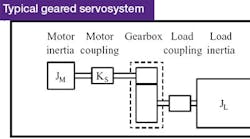One advantage of using a gearbox is that it gets you more motor bang for your buck. Electric motors are sized according to the torque they produce; more torque usually translates to larger, costlier motors. Because gearboxes multiply torque, they essentially let a small motor to do a big motor's job. In a majority of cases, geared servomotors are smaller and less expensive than their non-geared counterparts, even when you consider the cost and size of the gearbox.
Besides saving money, gearboxes also mitigate the effects of resonance, the selfsustained oscillations that occur frequently in servosystems (see Tune-up, Oct. 1999). The addition of a gearbox alleviates resonance problems because it reduces the reflected inertia of the load. Reflected inertia is that which the motor senses from the input side of the gears.
Consider a typical geared servosystem with a reduction of N:1. Assuming the use of ordinary couplings, the inertia seen by the motor is reduced by a factor of N2. If the gear reduction is 2:1, for example, the reflected load inertia will be (1/2)2, or just 25% of the actual load inertia.
Resonance, as you probably already know, is particularly difficult to deal with when the load inertia is much larger than that of the motor. Imagine a system where a load inertia of 0.002 kg·m2 is driven (directly) by a servomotor with a rotor inertia of 0.0002 kg·m2 motor inertia is 10:1, which is a challenge to control even with modest response rates (60-Hz bandwidth).
Problems associated with mechanical resonance have increased substantially in recent years. One reason has to do with the emergence of low-inertia brushless motors. Because of their construction (see Tune-up, Sept. 1999), the rotors on brushless motors are commonly five to eight times lighter than those on equivalently sized brush motors. This is usually considered an advantage – it reduces weight and improves acceleration – but on a machine originally outfitted with a brush motor, switching to a brushless motor can invite instability problems due to the subsequent increase in load-to-motor inertia ratio. When swapping motors, it's not uncommon for inertia ratios to jump from about 2:1 to a potentially unstable 10:1 or more.
Another reason resonance problems are on the rise is that modern machines require faster response, which in turn, demands higher servo gains. Higher gains, of course, make machines more sensitive to resonance.
It should be noted that a common misconception surrounding load-to-motor inertia is that the inertias must be matched to optimize system response. While experience does show that a responsive control system usually requires a smaller load-to-motor inertia – the most responsive systems, in fact, require a load inertia no larger than about 70% of the motor inertia – ratios of up to 5:1 or more can work in servo applications.
Although gearboxes help servos perform better, they are not without drawbacks. One problem is lost motion. Lost motion is the difference between the actual movement of the output shaft and what it would have been had the gearbox provided ideal gearing. Most of this disparity is due to backlash, a mechanical phenomenon where a small clearance between gear teeth causes a discontinuity in motion when torque is reversed. Backlash is especially troublesome when it is associated with the motor feedback sensor that closes the servo loops. Most applications specify backlash as a portion or fraction of overall system accuracy.
Another disadvantage with gearboxes is that they possess mechanical compliance or springiness. In other words, the input shaft winds up a little when transmitting high torque. This effect can be safely ignored in many machines because the motor-gearbox coupling is usually the dominant source of mechanical compliance.
A final word of caution on gearboxes applies to those with high reduction ratios. In general, it's best to avoid gearing that requires more than 3,000 to 4,000 rpm from the motor. High-speed gearboxes often are noisy and have a relatively short life due to wear. Although various gear geometries (see Brushing up, Nov. 1999) have been developed to reduce noise, error, and backlash, these improvements are often costly and some actually reduce gear life.
Instant resonance reduction
If you want to become more familiar with the advantages of gearheads and their effect on reflected inertia, then log on to www.motionsystemdesign.com and download the free control system simulator, ModelQ. After installation select the March 2000 model in the combo-box at top center and click "Run."
On your computer screen, you'll see a scope display of a simulated velocity controller, with the command signal in black and the feedback signal in blue. The compliance Ks is 3,000 Nm/rad, chosen to represent the motor coupling. Initially, the gear reduction will be one-toone and the system nearly unstable because of resonance generated by a 10:1 load-to-motor (0.002:0.0002 kg·m2) inertia ratio.
After you're comfortable with what's going on, try reducing the inertia ratio by using a 2:1 gearbox. In this case, the reflected load inertia (JL/N2) is 3.5 times the motor inertia.
You'll notice that changing the gearing also requires a corresponding change in the tuning gain. Without a gearbox, a KVP of 0.4 was found to work well. With a gearbox, however, the total inertia JT is reduced by a factor of three, necessitating a proportional reduction in the tuning gain to maintain similar servo performance. This lower gain (KVP = 0.13) not only improves the inertia ratio, but also eliminates resonance.
Experiment for yourself and you will discover that the higher you set the servo gains (especially KVP), the larger the gear reduction you will need to avoid resonance.
George Ellis is Senior Scientist at Kollmorgen Inc., Radford, Va., where he does research and design in motion control. His new book, Control System Design Guide, (2nd Edition), is scheduled to be published by Academic Press later this year. You can contact George at [email protected].


